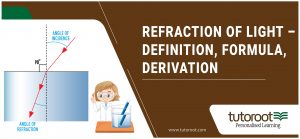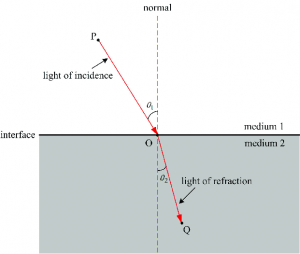Refraction of Light – Definition, Formula, Derivation
Light is a very important quantity or form of energy that undergoes various changes or produces different effects based on multiple parameters. And here in this article, we will talk about one such parameter, called the Refraction of Light.
Refraction of Light
When light passes from one surface to another, it causes the bending of waves, which is referred to as the Refraction of the Light. The main reason behind the bending of the light wave is the difference in density of the materials on two surfaces, from which the light is passing through. Theoretically, it is defined as the change in the direction of a wave passing from one medium to another.

However, the Refraction process is not common in Light, but also in sound waves as well as water waves. Moreover, the refraction of light is the principle that is generally used in various types of optical instruments, like, Prisms, Lenses, and Magnifying Glasses. It also allows us to view or see our surroundings, as we are able to focus light on our retina.
Laws of Refraction of Light
There are two Laws of Refraction of Light, which are,
- The first law states that the incident ray, reflected ray and the normal to the interface, all exist in the same plane.
- According to Snell’s Law of Refraction suggests, the ratio of the sine of the angle of the incidence and the sine of the angle of the refraction is constant.
Sin i/Sin r = n
N = refractive index of the denser medium.
Why is Refraction Caused?
Now in this section, we will talk about the main reason behind why the refraction is caused.
Change of Speed
Whenever a light ray enters from one medium to another it undergoes refraction. And in this process, the change in speed plays a very important role, as the higher speed will cause a higher change in direction. For instance, consider a light ray traveling into the water.

In the above diagram, you can observe the light ray entering from one medium to another. And due to the speed of light rays, the refraction of light rays either increases or decreases. Moreover, the refraction of light as said above depends on the density of the medium. For instance, if the density of the medium is higher, then the inclination of the light ray in the second medium will be more toward normal.
Definition of Refractive Index
The Refractive Index plays an important role in explaining how the process of refraction works, and how it varies based on the type and density of the medium, as well as the speed of light. In theoretical terms, it is defined as the ratio of the speed of light in a vacuum(c) and the speed of light in a medium(v).
n = c/v
According to the refractive index, if a light ray passes from a medium with a lower refractive index to a higher refractive index, it bends towards normal. And if it passes from a higher refractive index medium to a lower refractive index, it bends away from the normal.
Applications of Refraction
Refraction is a very popular concept, and it is actively used in various applications all the time.
- People who have short-sightedness or long-sightedness, actively use spectacles made using the principle of refraction.
- Magnification glasses or other similar equipment also use the principle of refraction to form the image.
- Other than this, it is also actively used in various other products or applications such as telescopes, cameras, movie projectors, etc.
Conclusion
In the above article, you have learned all the light refraction, laws of refraction of light, and the various reasons behind the refraction, as well as about some of the popular applications of refraction. And as you know from the above article, these topics are not very easy to understand, and it is better for students to make use of online coaching platforms. One such platform is Tutoroot, which is currently offering cost-effective online interactive classes with various benefits such as doubt-clearing sessions, access to the best educational material, expert staff, and a lot more.
Frequently Asked Questions
What is Refraction?
Refraction is defined as the process of bending light rays when they travel from one medium to another.
What is Atmospheric Refraction?
Similar to refraction, when a light ray passes through the atmosphere, it also undergoes refraction, due to multiple layers with varying densities.
